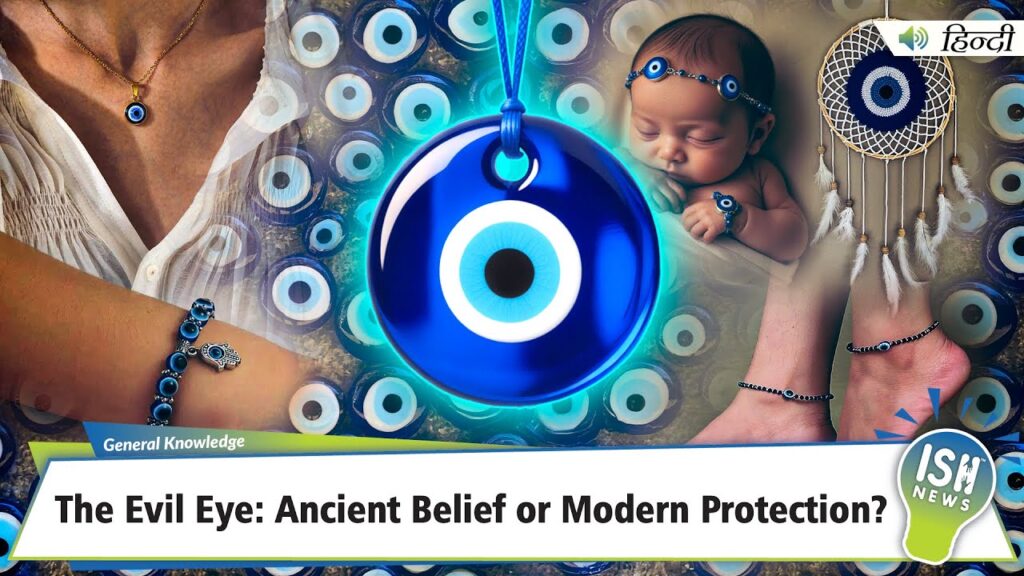The Evil Eye: Ancient Belief or Modern Protection? | ISH News

Have you ever been told not to post too many joyful or successful pictures online because “nazar lag jayegi”? It’s something many of us have heard from elders, friends, or family. But what exactly is this nazar or evil eye? The concept is an ancient one, believed to have originated over 5,000 years ago, with early references found in Mesopotamia, Egypt, Greece, and Rome. Across these cultures, people believed that too much admiration—especially if laced with jealousy—could invite misfortune, illness, or accidents. The idea was simple: when someone looks at you with envy or unspoken resentment, their gaze can unintentionally transfer negative energy, disrupting your happiness, peace, or health.
As civilizations grew and people migrated, the belief in nazar spread across continents. It became deeply rooted in countries like Turkey, Iran, Italy, Mexico, and of course, India. In each place, it took on slightly different forms and symbols, but the core belief remained the same—excess attention or praise can attract negative energy. In India, for example, people often put black dots behind ears of babies, or tie lemon-chilli to vehicles and doors to ward off nazar. In the Middle East and Mediterranean, the iconic blue-and-white evil eye amulet became a widely accepted symbol of protection.
This amulet, often designed to resemble an eye, is believed to serve as a shield—absorbing or bouncing back any harmful gaze. It’s not uncommon today to see people wearing evil eye bracelets, necklaces, or even placing them on keychains, baby strollers, phones, or cars. While for some it’s a deeply spiritual object, for others, it’s a fashion accessory—blending style with symbolism.
Interestingly, there’s also a belief that if your evil eye item—be it a pendant, bracelet, or wall hanging—suddenly cracks or breaks, it means it has absorbed a particularly strong dose of negativity meant for you and was destroyed while shielding you. That’s why many people replace broken evil eye items immediately.
Even in our modern, digital lives, this ancient belief continues to stay relevant. In the age of social media, where we share moments of joy, luxury, love, and success with the world, many feel more vulnerable to nazar. Whether you believe it or not, the fear of being “too visible” or “too admired” still exists.
So, is the evil eye just superstition? Or is it a cultural truth rooted in generations of collective experience? Whether you see it as spiritual protection, a cultural tradition, or just an aesthetic trend, one thing is clear: the evil eye has survived centuries, empires, and now the internet age.
What do you think? Do you believe in nazar or the evil eye? Have you or someone you know experienced it? Share your story in the comments—we’d love to hear!
#EvilEye #Nazar #AncientBeliefs #SpiritualProtection #NazarLagna #Superstition #BlueEyeAmulet #CulturalTradition #NegativeEnergy #EvilEyeStory#IndiaSigningHands #ISH #ISHNews #ISL #IndianSignLanguage #SignLanguage #Information #India #Deaf #DeafCulture #DeafCommunity #Awareness #DeafAwareness #IndiaDeaf #DeafIndia #News #NewsChannel #DailyNews #DailyNewsIndia #BreakingNews #NewsAlert #Updates #InstaGood #InstaDaily #Igers
ISH News broadcasts the Daily News and Entertainment online in Deaf-friendly accessible formats which are in Indian Sign Language (ISL), visual images with titles, voice-over and closed-captions. This ensures that we provide equal access to every individual, whilst promoting awareness.
Follow us for all the latest News & Entertainment and to keep up-to date on all the happenings at ISH News:
WhatsApp Channel: https://ish.news/ish-whatsapp
Facebook: https://www.facebook.com/ISHNews/
Twitter: https://twitter.com/ishnews_tv
Instagram: https://www.instagram.com/ishnews/
Official Site: http://www.ishnews.tv/
Thanks for watching!! Favourites, Likes, Feedbacks & Shares are always appreciated.
source

I can't believe thing ring important. . People must pray strong to God protect everything real. The ring are different things science fake so
@dipalizende8139
I want to know, what do mean eye evil?
@bestteendancer84
Thanks🧿
@DurgeshTamrakar-k5z
My understand accepted thank you
@TaniyaBhadra2002-bc7jq
Yes me..
@anuradhanikale-jh3ni
I don't know first I understand
@ajayraik__096
Yes…. Correct
@nilakanthadas426
Yes maybe 🤔
@devanathanparthasarathy6557
Sure 💯
@devenkulkarni7375
Thing cannot power but God only so you must pray to God can protect you everything…..
@jacobdivya1985
Yes. Same it
@nirupamaartist4506
Yes right 👍
@Austin6600
I don't believe that.
@LituNayak-21
Believe noting
@RahulShelke-m1l
Yes, I did experience my ring
@mamtaroshni4812
Yes l safe
@anjalitadungdung8219
I don't believe
@ubalakistappa
I don't believe
@sunithabollepalli9523
I don’t believe it
@Hxphilipjr10
I don't believe it
@kishormohite18
I proud not evils eye 🧿🧿🧿
@umardeaf_mumbai007
Yes 👍
@girishkumargadat3892
I believe yes
@Gurudwara_bababakala_sahib
Not Belive
@mangeshyadav2398
Yes I'm know family is culture is 🧿 safe True'm belive you
ISH news Thank you team' ISH
@ShivaniGhule-w5z
Thanks you 👍
@mdraza7549
Hello ISH thanks you!!
@Suresh2as
❤🧿
@ranjeetluthra10
Fake
@Cristnie
Yes right ✅️
@ManishSingh-k6x
Yes I know 🧿
@akashghanate9414
Yes right perfect
@Amar-or2nb
Thanks for sharing news🧿🧿🧿
@prydeafofnepal1616
I understand it. 😢😢🧿🧿
@GulnarShahjadi
Know good same year ye
@suniljaatdeaf95
I don't believe, muslim rules haram (SIN)
@swalheenansari9424
🌏🧿✅️
🛡👎🏼👁👺
🛡👎🏼👁👩🏼🦳🧔🏽👱🏽♀️👳🏽♂️👴🏽👵🏽🧓🏽🤡
@SiamoL-p2k
🧿
@stanlyabraham100